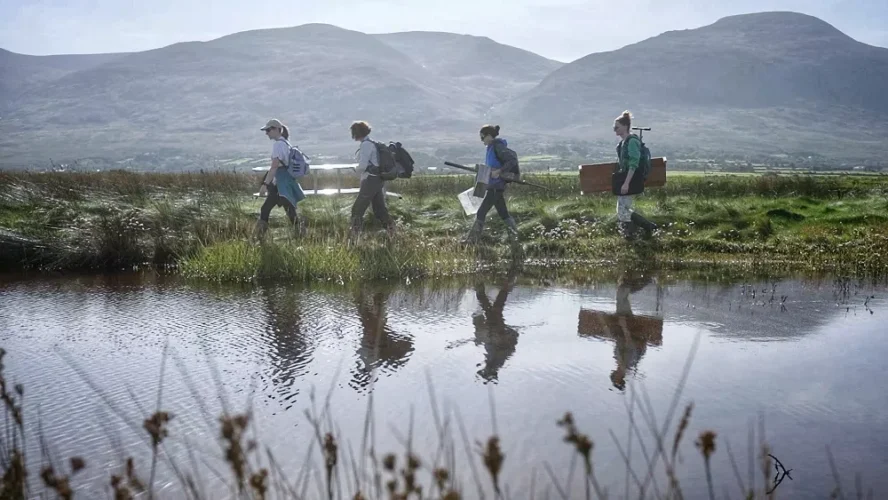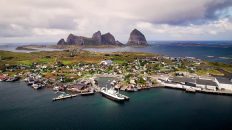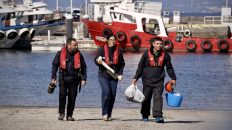When it comes to fighting climate change, we often think about planting more trees. But coastal wetlands capture and store carbon even better than tropical forests.
In this episode of Ocean, we travel to Ireland, the Netherlands and Italy to find out if we are overlooking a climate change solution that’s right under our feet.
Ireland’s CO2-storing salt marshes
With every high tide, the waves of the Atlantic wash over Derrymore Island marshes. It’s more than a scenic view; it’s a natural carbon sink. A team from University College Dublin is here to study just how well these marshes help remove carbon from the air.
“Salt marshes are a tidally inundated habitat, so they’re low-lying, and the plants that live here — they need to be able to tolerate the salty conditions and also the waterlogged conditions, that actually make salt marshes good at storing carbon,” explained Grace Cott, a coastal wetland ecologist at University College Dublin.
All plants capture CO2 to grow, but on dry land, they release most of that carbon back into the air when they decompose.
Marsh grasses are different: saturated by salty water, they’re less likely to break down, keeping their captured carbon in the soil.
“We’re trying to really get a sense of exactly how much carbon is being stored in this habitat, and then we can propose different ways of managing these habitats so that they can continue to store carbon,” Grace Cott added.
The key tool for this research is the eddy covariance tower — a sensitive instrument that tracks the exchange of gases between the soil and the atmosphere, indicating the actual amount of carbon the marsh is capable of storing.
“What we calculate here is the fluxes of carbon dioxide and water vapour,” revealed Lisa Jessen, a researcher in saltmarsh ecology at University College Dublin.
“We are seeing CO2 uptake during the daytime because of photosynthesis and then CO2 carbon dioxide emissions at night time because of plant respiration.”
This thriving wetland is capturing more carbon than it’s letting go. But this only happens when conditions strike a balance, not too wet and not too dry.
“When the systems get flooded, they really struggle to continue to work properly,” Environmental Scientist, Elke Eichelman, told Ocean.
“In the other extreme, if we drain the ecosystem for, say, agricultural use, that really detrimentally affects the system and releases a lot of carbon.”
If coastal wetlands deteriorate, they can turn from a carbon sink into a carbon source, exacerbating climate change.
“Coastal wetlands around the world are under threat by development, agriculture and also sea level rise,” Grace Scott explained.
“Within Ireland particularly, we have lost a lot of salt marsh habitats over the last number of years, but also globally, that’s true as well. And is true for mangrove forests and is true for seagrasses.”
Rewetting peatland in the Netherlands
Draining a wetland triggers the decomposition of organic matter stored over the centuries.
Dutch polders are a good example. Underneath these green fields in northern Holland is peatland – a type of wetland where conditions stop plant material from fully decomposing.
At nearly five meters below sea level, water has to be pumped out continuously to keep the land dry for dairy cows. But this patch has been re-wetted, and now Typha plants, also known as cattails, are sprouting from peatland submerged in about 15 centimetres of water.
Because the soil is no longer exposed to oxygen, it’s not releasing nearly as much CO2 from decomposing peat.
Aldert van Weeren, from Wetlands International Europe is running this experiment. He thinks this could be a greener alternative to traditional dairy farming in the area.
“The amount of carbon which is attached to one litre of milk produced on these meadows is about the same [amount] as burning two litres of benzene petrol in your car,” he explained to Ocean.
“At the moment you re-wet, there are no carbon emissions coming from this area anymore. But then you can’t have cows running around and grass. So you see a different crop. And instead of being a dairy farmer, I am now a fibre farmer!”
The plant is naturally strong, flexible and resistant to rot. Aldert van Weeren sees big potential for its fibres — from non-woven fabrics to greener construction and packaging materials.
“It’s almost impossible to crank it. You can try what you like, you can even stand on it — it’s a very stable structure because of these cells and its sponge system in there. And it makes it a good building material and a perfect insulation material,” he explained.
“That’s what we think will be the future of farming — this kind of thing, making nice building material for the city of Amsterdam in the background.”
Possible financial incentives for cutting down emissions and restoring natural habitats could help make this land use financially viable in the long term. Plus, new lightweight machines could propel wetland farming to a larger scale, turning captured carbon into sustainable building materials.
“This is made of just chopped cattail layers on top of each other. As a binder, we use magnesium oxide. It’s not burning, it’s self-supporting, and it’s an insulator,” said Aldert van Weeren.
“Those cellulose fibres mixed with water gave you [a] kind of board — just made from pure plant fibres without any binder. This is a hydromechanical binding! People don’t believe it, but it’s true, it works!”
The secret of Italy’s seagrass
Coastal carbon capture isn’t limited to land — it’s also happening underwater.
A lagoon in Italy’s Emilia Romagna is a natural fish habitat used for extensive aquaculture. The patches of seagrass provide more than just an ideal nursery for fish: globally, these underwater plants capture 10% of all the carbon buried in ocean sediment.
Half a century ago, all local lagoons were carpeted with seagrasses. Most of these plants have since been wiped out, likely due to pollution. Now, a European-funded project LIFE-TRANSFER is replanting surviving grasses in nearby lagoons, inspired by promising results from a pilot site near Venice.
“We need to reverse the process, so we have to reach a phase where the seagrass is expanding, as has happened in the Venice Lagoon,” said LIFE-TRANSFER project coordinator, Graziano Caramori.
“We have a good example of a success story that we want to export throughout the Mediterranean, and not only that — across all of Europe.”
Led by Graziano Caramori, the research team has come up with a method to give seagrasses a new home. They lift patches from a donor site and swiftly move them to another spot with similar characteristics.
Their aim is to boost the odds that these underwater plants turn into lush seabed meadows. In the long term, this should result in cleaner water, less coastal erosion, and new safe havens for aquatic wildlife. This work is being done in Italy, Greece and Spain.
“We will certainly be giving an enormous gift to the environment by improving the biodiversity of the area — but we’ll also be giving a gift to ourselves, increasing the capacity for CO2 sequestration, and as a result, making a contribution to the fight against climate change,” concluded Michele Mistri, a professor of marine ecology at the University of Ferrara.
From salt marshes to seagrasses — some of the best solutions to the climate challenge are right at our shorelines.





